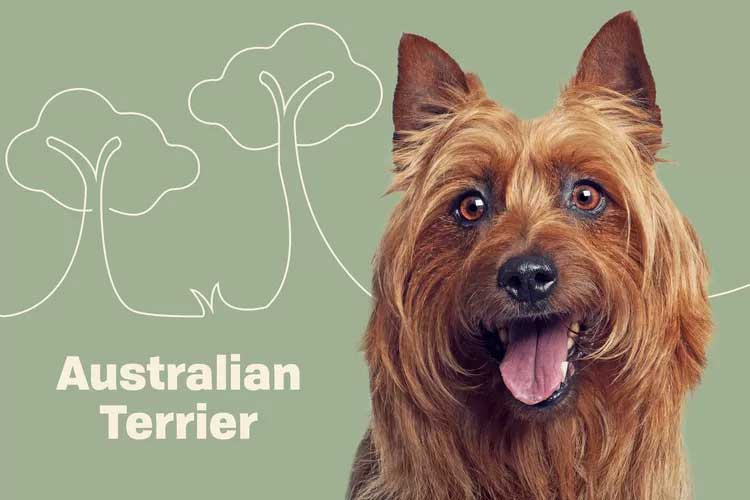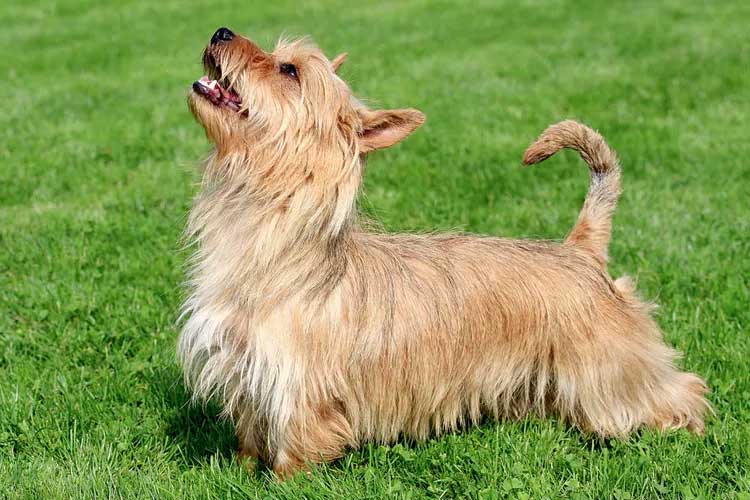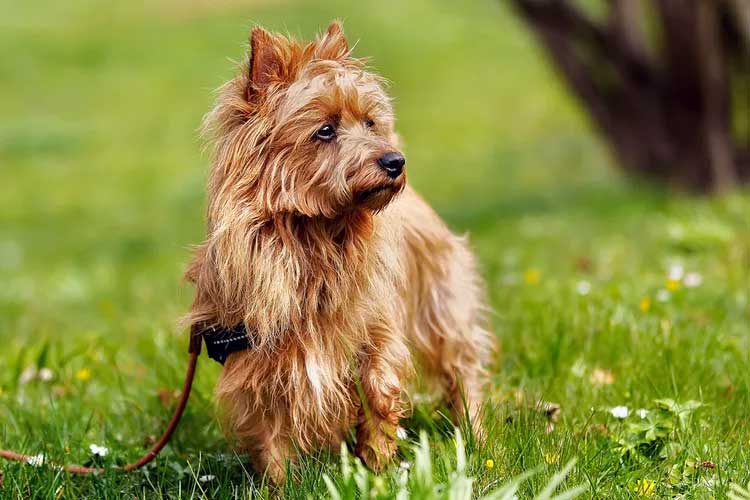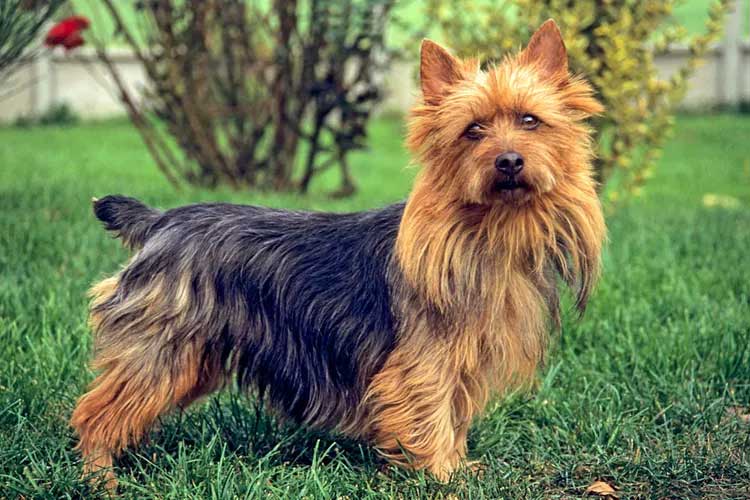Australian terriers are small pups that make excellent family dogs, but often prefer to be the only pet in a household. They are playful, high-energy, and affectionate.

Australian Terrier Overview
| OFFICIAL NAME | Australian Terrier |
| COMMON NAME | Australian Terrier |
| PET HEIGHT | 10 to 11 inches |
| PET WEIGHT | 15 to 20 pounds |
| LIFESPAN | 11 to 15 years |
| GOOD WITH | children, families, seniors |
| TEMPERAMENT | playful |
| INTELLIGENCE | high |
| SHEDDING AMOUNT | infrequent |
| EXERCISE NEEDS | high |
| ENERGY LEVEL | hyper |
| VOCAL LEVEL | frequent |
| DROOL AMOUNT | low |
| BREED GROUP | terrier |
| BREED SIZE | small (0-25 lbs.) |
| COAT LENGTH | medium, short, wiry |
| COLORS | black, blue, red |
| PATTERNS | bicolor, black and tan, blue and tan, sable |
| OTHER TRAITS | apartment-friendly, easy to groom, easy to train, good for first-time pet owners, high prey drive, hot weather tolerant |
Australian terriers are playful, busy little dogs that love quality time and bonding with their humans. Their motto: "Work hard, but play even harder." Don't let their small size and playful disposition fool you, though; they're just as courageous as they are sensitive.
Although tiny for a working terrier (just 15–20 pounds), these self-assured pups were bred to fearlessly hunt vermin in remote regions of Australia. Though sometimes called "Aussies" by their adoring fans, these pups aren't to be confused with Australian shepherds.
Highly intelligent with an easy-to-groom, low-maintenance coat, Australian terrier dogs can make great first-time pets. But take note: One of their quirks is that they relish being the only family pet and may not get along with other dogs.
Australian terriers are charming, and they have a knack of turning their human companions into lifelong devoted fans of the breed, though they're still somewhat of a rare breed in the United States. These dogs will be happiest in homes where they get loads of attention and—it's worth repeating—playtime is a priority.
Appearance
The Australian terrier's torso is long, especially in proportion to his height. He measures just 10–11 inches tall and is among the smallest of the working terriers. With his stubby yet strong legs, he has a low-to-the-ground barrel body that's vaguely similar to corgis and dachshunds. Australian terriers typically weigh 15–20 pounds.
These terriers have an easy-to-maintain coat that's either blue and tan, sandy, or solid red. Their outer coats are short and wiry with softer undercoats. As a juxtaposition to their mostly harsh fur, these terriers wear soft and silky topknots on their noggins and between their perky, triangular ears.
While not considered hypoallergenic, Australian terriers don't shed much and could be an ideal pet for allergy sufferers, according to the Australian Terrier Club of Great Britain.
His confident trot matches his self-assured disposition. Australian terriers have small, dark brown or black eyes that reveal a keen, intelligent expression, according to the Australian Terrier Club of America (ATCA).
Temperament
A true terrier, these pups are playful, highly energetic, and spunky. Once they've burned off enough energy, they might just sit still enough for some cuddles. But to really grasp the nuances of this breed's personality, it helps to understand the Australian terrier's background."A small, yet courageous and bold terrier, Aussies were bred to hunt rodents," says Nicole Ellis, CPDT-KA and pet lifestyle expert with Rover.

This hunting instinct remains with them today, which means it's in their nature to chase down squirrels, rabbits, and other small animals—maybe even the family cat.
"People need to remember that they are ratters," says Pam Nichols, DVM, president of the American Animal Hospital Association. "They will not back down and can be tenacious."
So, even though Australian terriers are super smart and highly trainable, they shouldn't be allowed to run loose. Their families need to leash train them with positive reinforcement, otherwise they might just take off down the street in pursuit of a squirrel—and they won't stop to look both ways before crossing a busy street.
They also have a reputation of being very vocal (aka, they bark a lot), Nichols says, often sounding the alarm whenever a stranger approaches the house.
Because these dogs forge super strong bonds with their humans, many prefer to not share a household (or attention!) with any other pets. But with their playful and loving personalities, Australian terriers usually do well with human siblings (aka children) and they can make great family pets.
Living Needs
Because Australian terriers were bred to work alongside humans, often under stressful conditions, they developed a strong sense of devotion to their households, according to the ATCA. To this day, these terriers are happiest when they're with their people and are best suited for a household that can spoil them with attention. This includes playing with interactive toys, enjoying a game of fetch, or snuggling on the couch."Although small, Australian terriers have a big dog personality and plenty of energy," Ellis says. "They generally grow very attached to their family ... but need an outlet for all that working dog energy."
Australian terriers can be city dogs, happily taking up residence in an apartment, or they can live in the country. They can also adapt to most climates, hot or cold. But no matter where they call home, there's one important requirement: They need to have a safe space to exercise.

Not only do they have hunting instincts, but these terriers are quite springy and are known diggers. To put it another way: They can be little escape artists, skilled enough to scale a fence or dig themselves an exit path. Australian terriers always need to be on a leash or supervised in a fenced-in yard.
While all dogs have different personalities, Australian terriers often prefer to be the sole pet in the household. So, if you're thinking about adopting an Aussie or bringing another pet into your home, it's a smart idea to safely introduce the new animal to the family first to suss out the dynamic between your canine companions. Generally speaking, though, two male terriers probably won't be able to live together peacefully, according to the ATCA.
Care
Grab the training clicker and arm yourself with some treats: Australian terriers are smart and very trainable, especially if you can take a playful approach to sessions. They'll practically have basic training tricks down quicker than you can say "good boy!" For the best results, keep training routines short (but do them frequently) because these terriers can get bored quickly.
Again, because they were bred to be all-purpose exterminators and have chasing tendencies, teaching Australian terrier puppies to walk on leashes is a golden rule. If they take off after a rabbit, they may have a hard time finding their way back home.
Not only can training be a breeze with this breed, but grooming is also easy. Australian terriers have an all-weather coat that does a great job repelling dirt and mud. All they need is a once-a-week brushing. Refrain from giving your terrier frequent baths because the shampoo can soften their harsh coats, making them less resistant to dirt and leading to dry, flaky skin. Other grooming routines should include regular teeth brushing, nail trims, and occasional ear cleaning.
Like all terriers, Aussies have a high energy level. Not only do they need daily walks, but you'll also want to schedule in playtime with your pup to prevent boredom.
Health
Australian terriers have a long lifespan of 11–15 years and, in general, the breed has few health problems.Aussies can be prone to a few conditions, Nichols says, including diabetes mellitus, which means the dog's pancreas has damage and fails to produce insulin. Signs that your dog may have diabetes mellitus could include increased thirst, increased urination, changes in appetite, unexplained weight loss, fatigue, urinary tract infections, and cloudy eyes or changes in vision.
Patellar luxation, or dislocated kneecaps, can be another health problem Australian terriers face. It's also important to keep them free of fleas, because these pesky bloodsuckers can cause a range of reactions, from mild itching to extreme allergic reactions in these dogs, according to ATCA.

History
No surprises here! The Australian terrier was originally bred in the Land Down Under after British settlers brought several working terrier breeds to Australia in the 19th century. While their exact ancestors are unknown, the Australian Terrier Club of Queensland speculates they are descendants of the Skye terrier, Manchester terrier, and the Dandie Dinmont terrier.They were bred to hunt small mammals and snakes and also became devoted companions to their people. The first Australian Terrier Club was formed in Australia in 1887. Around that same time, Australian terriers were exported to Great Britain.
They were introduced to American households in the late 1940s, and by 1957 the Australian Terrier Club of America formed. The next year, nine Australian terriers competed in the "Miscellaneous Class" at the Westminster Dog Show. The American Kennel Club recognized the Australian terrier in 1960 as its 114th breed.
Fun Facts
According to the Australian Terrier Club of Queensland, these pups were originally dubbed the "broken coated terrier." In 1889, their name changed to the "Australian rough coated terrier."With heights of 10–11 inches and weighing 15–20 pounds, Australian terriers are considered one of the smallest working terriers.
Australian terriers were bred with Yorkshire terriers to create the smooth-coated silky terrier.